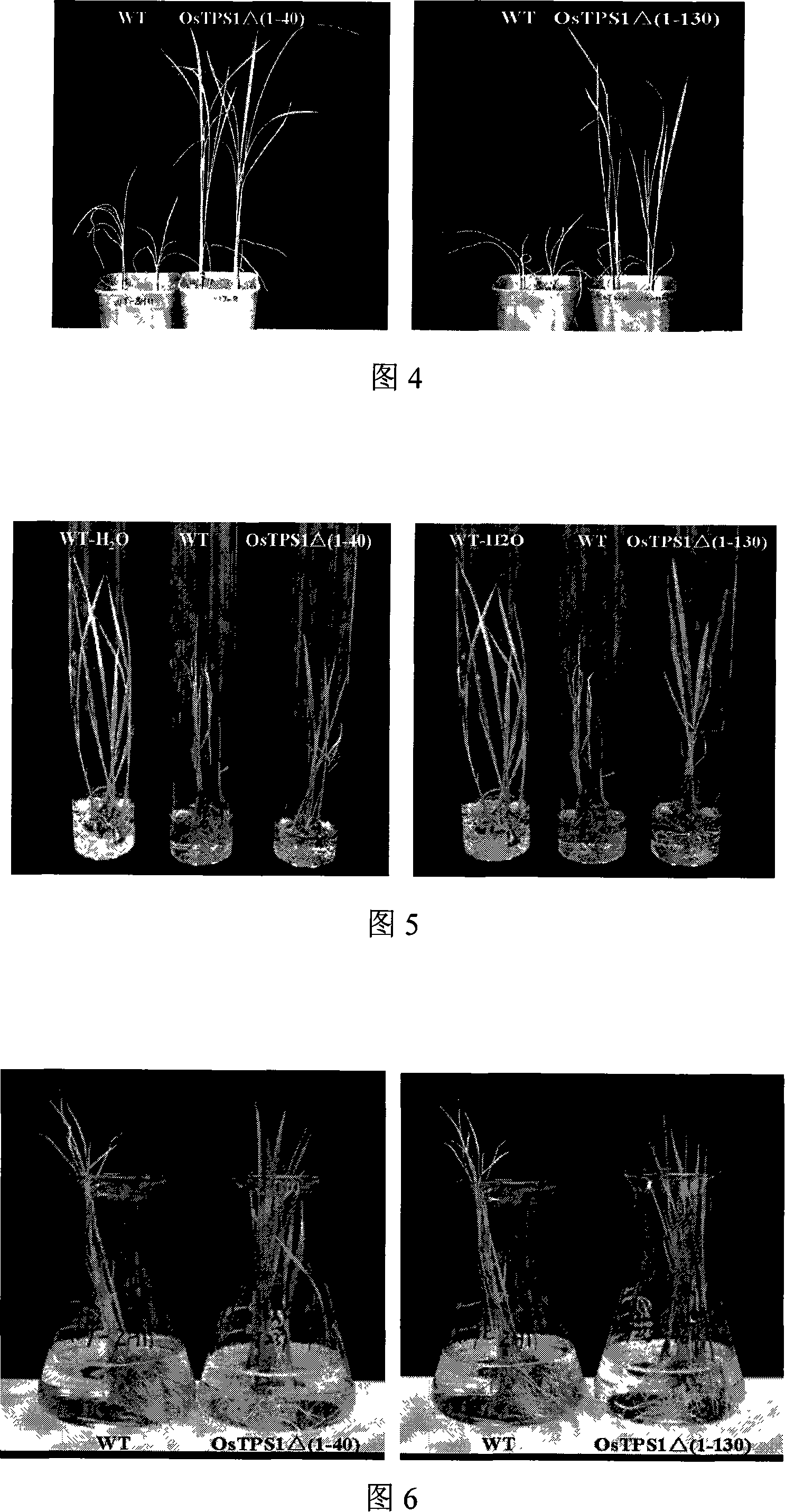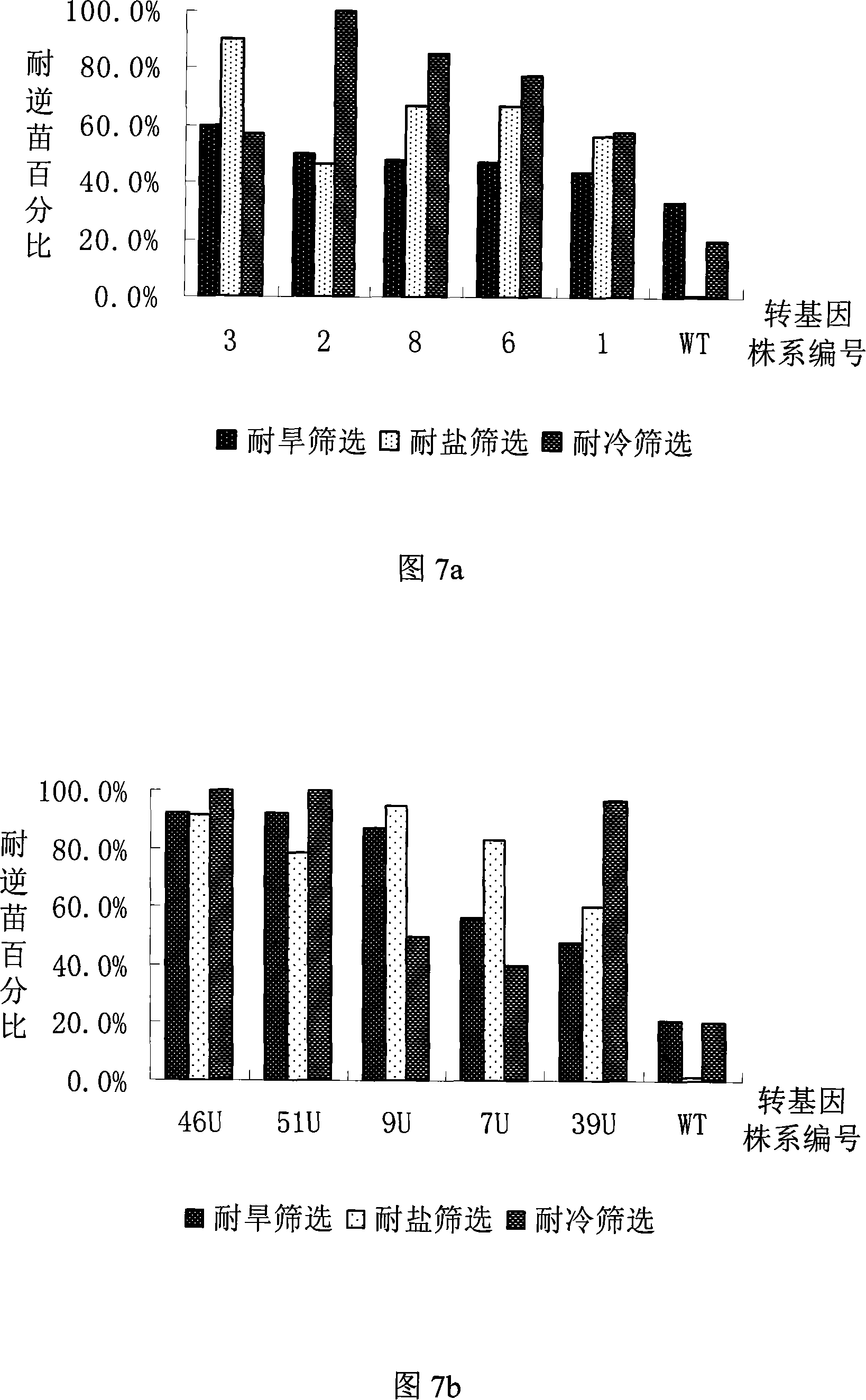Clone and application of rice trehalose synthase gene related with adversity resistance
A trehalose and gene technology, which is applied to trehalose synthase and its encoding gene and its application in cultivating stress-tolerant plants, can solve the problems of lack of cDNA or EST sequence experimental support, etc. promising effect
- Summary
- Abstract
- Description
- Claims
- Application Information
AI Technical Summary
Problems solved by technology
Method used
Image
Examples
Embodiment 1
[0040] Example 1. Acquisition of rice trehalose synthase gene OsTPS1 (OsTPS1Δ(1-40) and OsTPS1Δ(1-130)) related to stress tolerance
[0041] 1. Isolation and functional study of OsTPS1
[0042] Search the TIGR database, Huadade BGI database, and some other comprehensive databases such as NCBI to obtain the deduced coding sequence of TPS1. According to the prediction, its N-terminal extension region has about 128 amino acids, and there are three methionine (Met) in this region. ), we designed the 5' end primers starting with these three methionines respectively:
[0043] f001: 5' > CACCATGCCGACCCCCCGCGCC > 3'
[0044] f121: 5' > CACCATGCTCCGCGGGGAGTG > 3'
[0045] f393: 5' > CACCATGGGGATGAAGCAGCGCCTC > 3'
[0046] The 3' end primer sequence is r2958: 5'>GTCGACCTGCCTATCCAAGAACATG>3'
[0047] Extract the total RNA of Guangluai No. 4 rice at the filling stage, obtain cDNA by reverse transcription, use primer pair f001 and r2958 to amplify the full-length OsTPS1 gene by RT-PCR ...
Embodiment 2
[0049] Example 2. Obtaining of rice and stress tolerance-related trehalose synthase gene OsTPS1 (OsTPS1Δ(1-40) and OsTPS1Δ(1-130)) transgenic rice
[0050] We selected genes with N-terminal deletions of 40 and 130 amino acid residues to construct OsTPS1Δ(1-40) and OsTPS1Δ(1-130) to transform rice to detect the effects of different deleted gene fragments on rice stress tolerance. Using Agrobacterium-mediated transformation of rice, the specific method is as follows:
[0051] 1) Transformation of Agrobacterium
[0052] The recombinant plasmids pENTER-TOPO-OsTPS1Δ (1-40) and pENTER-TOPO-OsTPS1Δ (1-130) constructed in Example 2 were introduced into the plant expression vector pH2GW7 (Gateway of Invitrogen Company) by LR reaction respectively. TW vector carrier), the LR reaction system is 0.5μl Gateway LR Clonase TM Enzyme Mix (Gateway LR Clonase TMProvided in Enzyme Mix kit, Invitrogen), 1μl 5×buffer, 2μlpENTER-TOPO-OsTPS1Δ(1-40)(150ng / μl) or pENTER-TOPO-OsTPS1Δ(1-130)(...
Embodiment 3
[0058] Example 3, Identification of Drought Tolerance of OsTPS1Δ(1-40) and OsTPS1Δ(1-130) Transgenic Rice T1 Generation Plants
[0059]The pH2GW7-OsTPS1Δ(1-40) and pH2GW7-OsTPS1Δ(1-130) T1 transgenic rice seeds were harvested. Soak the seeds in water for 3 days to germinate them, then use 50 mg / L hygromycin for resistance screening, and use non-transgenic rice Zhonghua 11 as a control. After 5 days of screening, all the control plants died, and counted the resistant seedlings and dead seedlings of the transgenic plants To analyze the resistance segregation ratio of transgenic plants, obtain pH2GW7-OsTPS1Δ(1-40) and pH2GW7-OsTPS1Δ(1-130) transgenic lines with single point insertion, and perform Southern blot analysis to further identify the exogenous insertion gene copy number. Five different single-copy transgenic lines were selected for each gene, and the transgenic positive seedlings were subjected to drought treatment after continuing to culture for 10 days. At the same ti...
PUM
 Login to View More
Login to View More Abstract
Description
Claims
Application Information
 Login to View More
Login to View More - R&D
- Intellectual Property
- Life Sciences
- Materials
- Tech Scout
- Unparalleled Data Quality
- Higher Quality Content
- 60% Fewer Hallucinations
Browse by: Latest US Patents, China's latest patents, Technical Efficacy Thesaurus, Application Domain, Technology Topic, Popular Technical Reports.
© 2025 PatSnap. All rights reserved.Legal|Privacy policy|Modern Slavery Act Transparency Statement|Sitemap|About US| Contact US: help@patsnap.com



